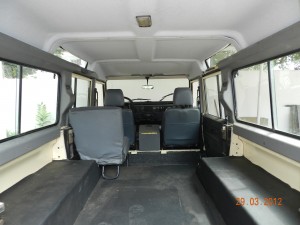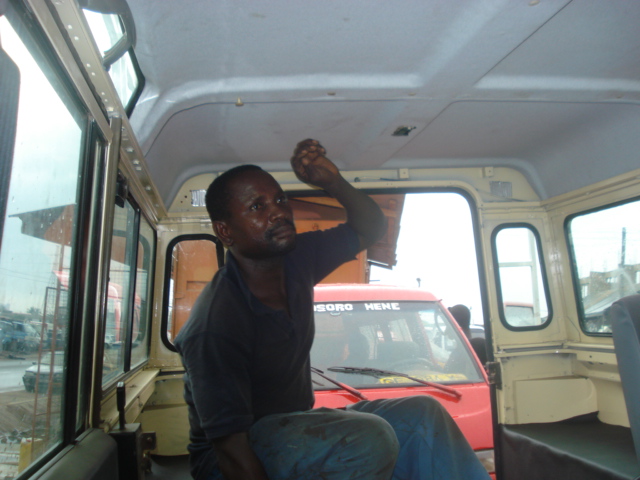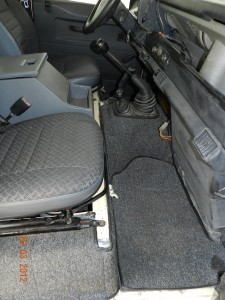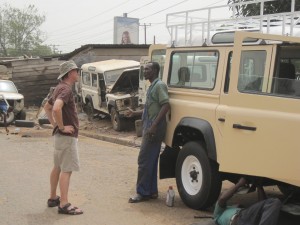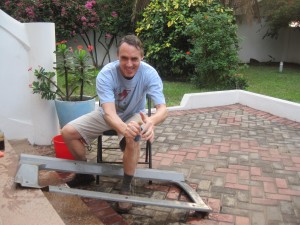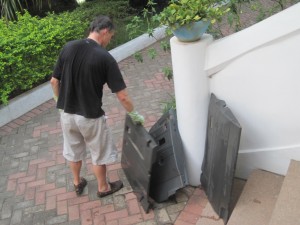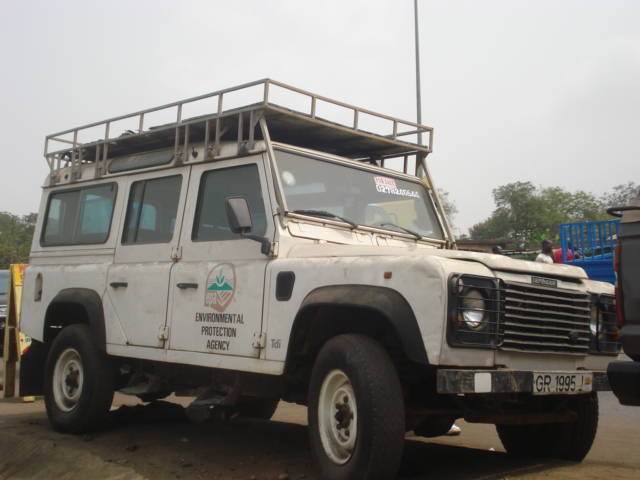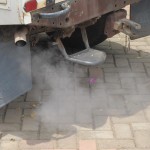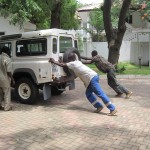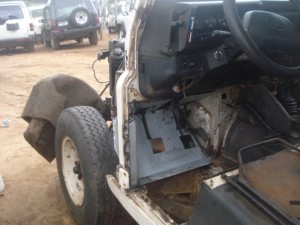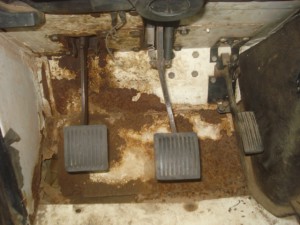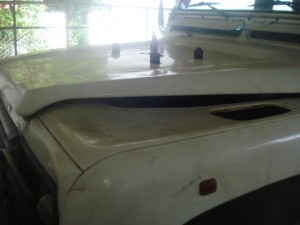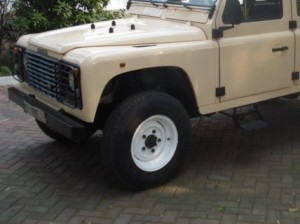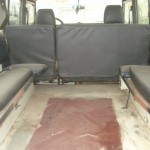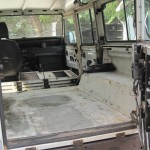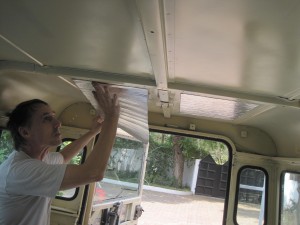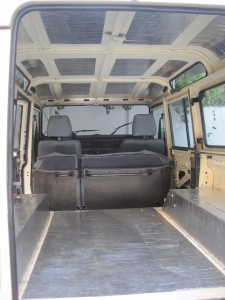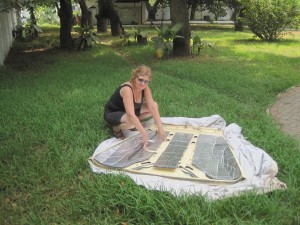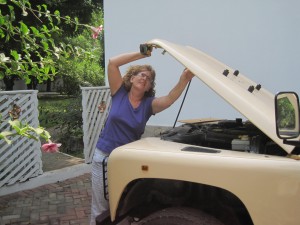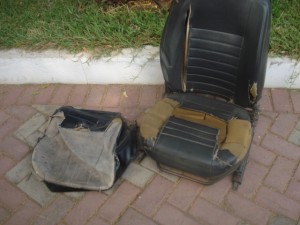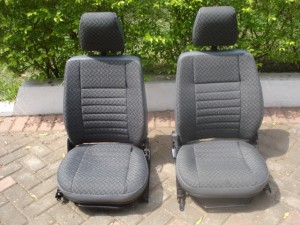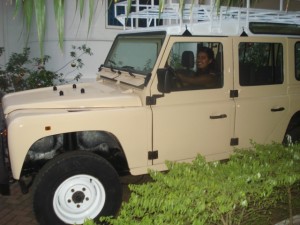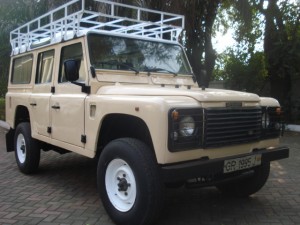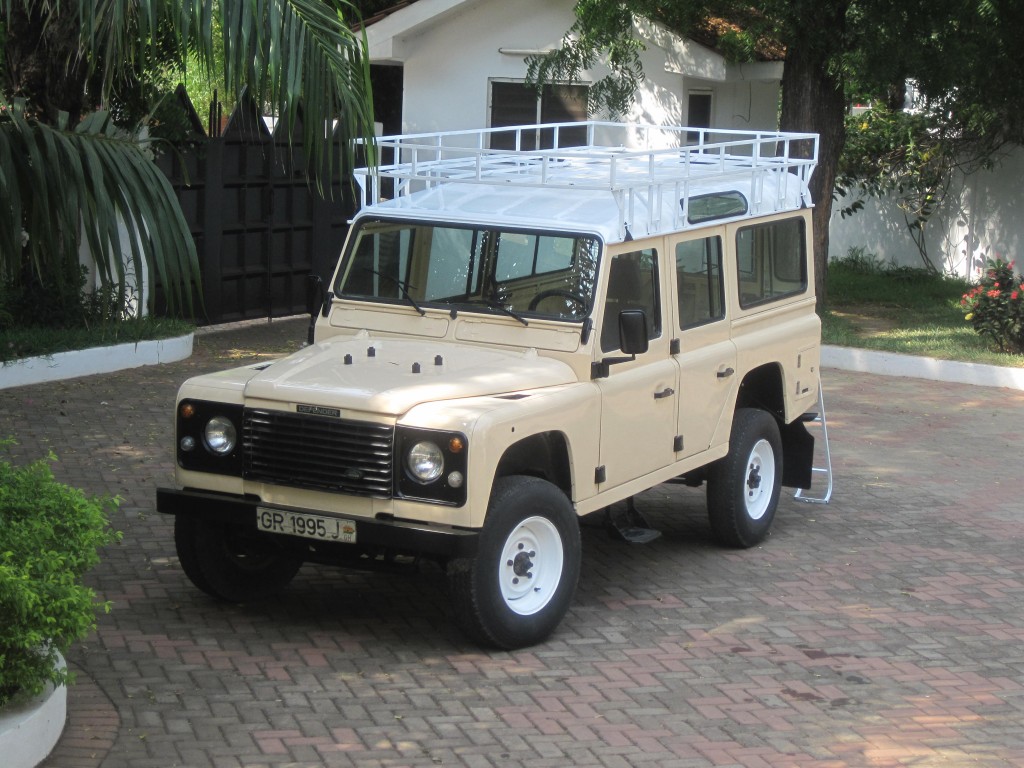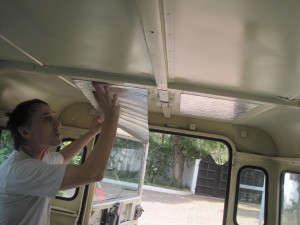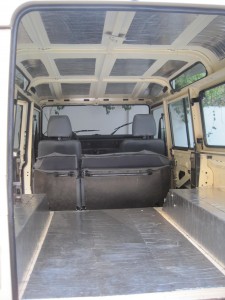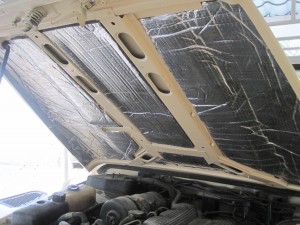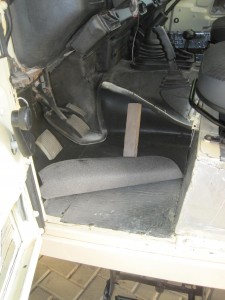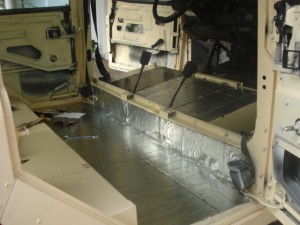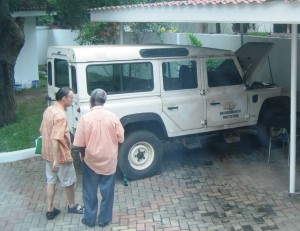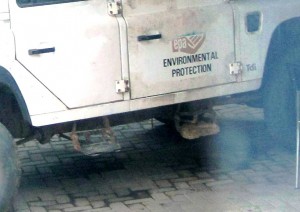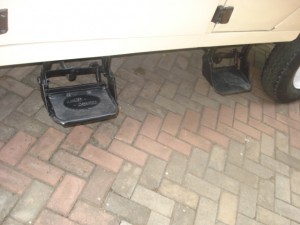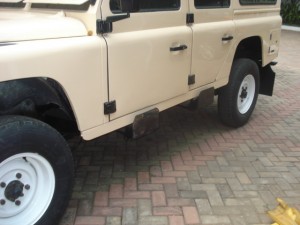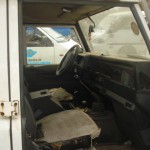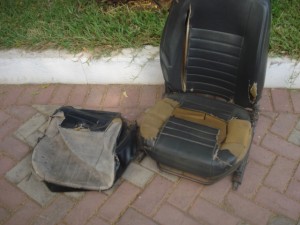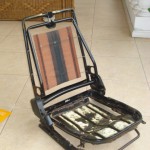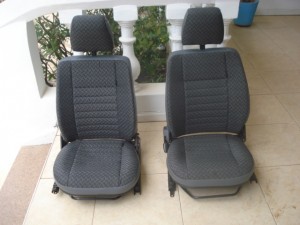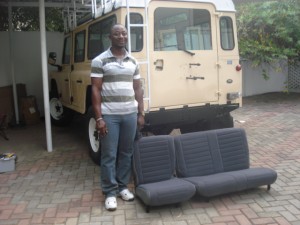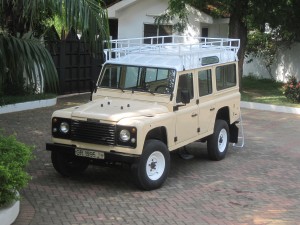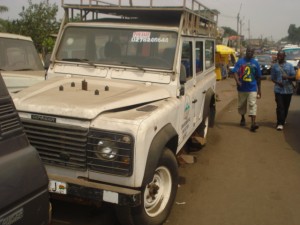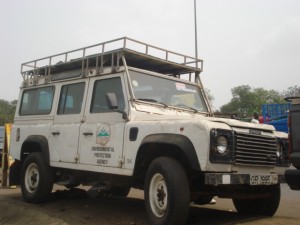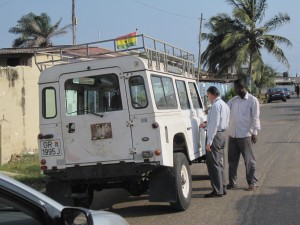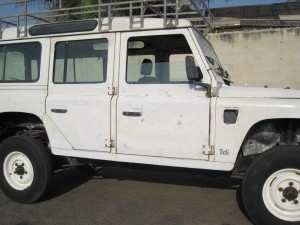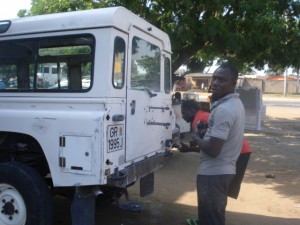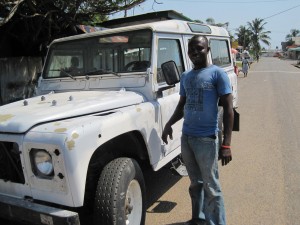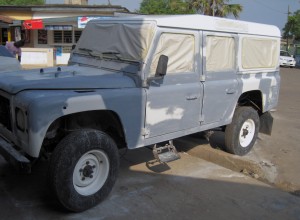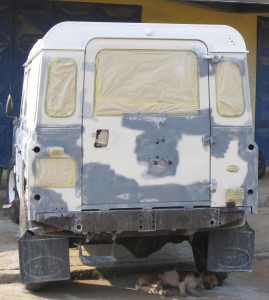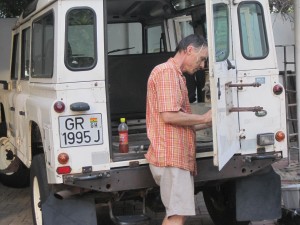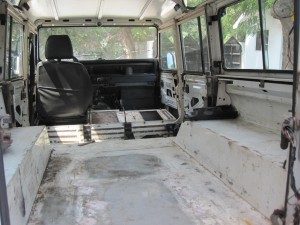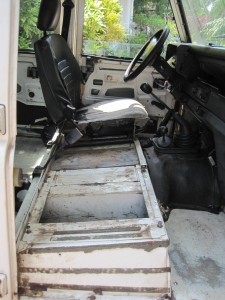With the soundproofing in we could then do the ceiling and the floor covering. For the latter we had decided even before we bought the vehicle that we wanted carpet on the floor, as opposed to the vinyl stuff that is used in many of the Landy restorations here. I can hear the off roaders groaning, I know carpet is not the first choice for the floor if you are going to be crossing rivers or doing any amount of real off roading. For that the bare metal floor is probably best. However, most of our travel will be on roads so we can afford to opt for the comfort and quiet that carpet is conducive to.
Paani had taken out the roof liners last fall to patch a couple of the holes left by superfluous electrical plugs we removed last year and the ceiling has been bare metal ever since. I had asked Paani one Saturday who did ceilings and he gave me the number of one Agomah, who keeps a shop near the Tesano area of Accra, not too far a drive from where we live. I called Agomah when I got back from seeing Paani one Saturday afternoon. Thanks to accent and vocabulary differences, telephone conversations between foreigners and Ghanaians are never easy affairs, particularly so if you have not met yet. Explaining who I was and what I wanted, and then getting into the logistical details of meeting was not easy and when we hung up I was really not sure we were on the same planet. We reviewed different options of times during the week when he might come to my house to meet me and see the vehicle. It is very common here for mechanics to make house calls, they are very quick to offer to come to your house. I love it but it sometimes can be awkward, maybe they often want to come when I am at work, or it is difficult for them to find where I live. Wanting to simplify this I suggested we meet in an obvious location known to both of us, at a time when traffic was light. This led to a rendez-vous at 8AM Sunday at Kwame Nkruman Circle, which in addition to being probably the most well known junction in Accra, is also midway between where I live and where Agomah’s shop apparently is.
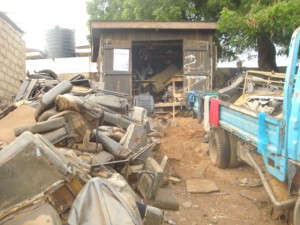
I called him at 7:30AM Sunday to confirm we were still on for 8:00 and to alleviate my fear that maybe we had completely misunderstood each other the day before. When I called Agomah said “but you said 8:00 o’clock” and I had to reassure him I was not looking for him yet, just wanting to confirm where and when we were meeting. I piled the old beat up roof liners into the back and headed off to Kwame Nkrumah Circle. The roof liner consists of three solid pieces of very firm but softish board that are about 1/4 inch think and covered with a fabric material. The problem in our Defender was the covering fabric was very dirty and discoloured and had become mostly detached from the board so it just drooped loosely.
Agomah and a colleague showed up at the right time in the right place in a tro tro and after looking at the Defender suggested we go up to his shop in North Industrial a short distance away to see materials. The shop is just another ramshackle shed, one of a number along a exitramp from a main Achimota Road leading into the North Industrial district. He had some samples of other recovered ceiling panels for me to look at that were quite lovely, and with some choices of colour. I settled on a very plain but bright gray, seeking to accent the dark gray dash and interior door panels.
Agomah not only had quality roof liner, but seeing that our Defender floor still only has soundproofing on it he was
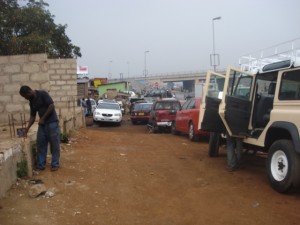
quick to pull out some ready cut carpeting pieces he had on hand for someone else, in a colour that matches our seats and door panels very nicely. The carpet is a short pile with a woven substrate and a smooth nonporous plastic backer. The set consists of 8 or 9 pieces that fit the front and back seat floor, over the transmission tunnel and around the seat boxes. When I said we did not want carpet in the cargo bay because it would not be functional and be too hard to clean Agoma came out with a heavy backed vinyl that he said they use quite often. Indeed it is probably the same vinyl that we had seen in the front of the Defenders and Opere restores and which was part of the inspiration to do our own restoration. As much as we may not have wanted it for the front, it looked just right for back.
Anticipating a moment like this I had brought with me for my own reference a quote I had received on ceiling and carpeting work from someone else a few months earlier. We got into price and I countered his original quote of GHC 500 (CAD 300) for ceiling and carpets with an offer of $450 (CAD 270). We shook hands on it and I gave him GHC 100 down, all the money I had in my pocket at the time. That was probably the most spontaneous of any decision I have had made on this project, and one of the best. The price was much lower that the other I had got earlier, from Michael who had done the back seat for me, and Agomah was recommended by Paani, who did my body work w (SEE SEPARATE POST) and that recommendation counted for a lot. We are very pleased with the result.
The best part was I did not even have to leave the vehicle with them, they just took my old ceiling panels to recover, the carpets they can produce based on their knowledge of Defenders, and if there were any doubt there were 3 or 4 Defender 110s I saw hanging about they could use for measurements.
It was sometime before I could get back to Agomah to have him install the roof liner and carpet, and I think he was wondering why after a couple of weeks I still had not returned. I was hesitating anyway because I wanted to run wires to the back for an outside area light and for speakers and thought I should do that before the carpet and ceiling went in. The problem was I was having trouble finding quality wire. With the lapsed time I was feeling guilty because I had given them such a small deposit and Laura and I were about to head for South Africa on two week holiday/outfitting gear shopping trip. Before we went away I went by and gave Agomah another 200 cedis, leaving a 150 cedi balance. I also picked the new liners and carpet up and brought everything home, having seen the “shop” I was a bit nervous that it could get dirty, rained on or otherwise damaged.
Finally on a Saturday in mid-March after we got back from our shopping trip to South Africa I was able to back to Agomah with the Defender and the ceiling and carpet pieces I had been safeguarding so he could finish the installation. It did not take very long, although I did have to ferry back to the house in a taxi to pick up a can of odds and ends that Paani had given me six months ago after he stripped the interior to do take the electrical plugs out of the roof and upgrade the doors that included, inter alia, the plastic plugs that are needed to put the roof liner in. Very pleased with the end product, they even put the mirror and sun visors back in and installed the interior ceiling lights front and back. Amazingly, the lights worked right away. The roof liner actually surpassed my expectations, the old ceiling was so loose that I thought I was going to get a new, clean fabric hanging loose, but instead I get a new, clean fabric fully moulded to the panel. It looks superb.
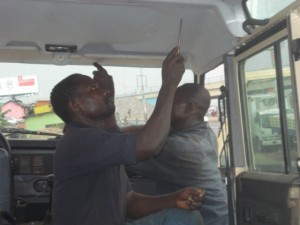
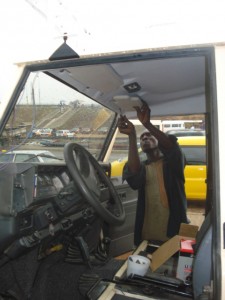
The carpets also went in, as well as the vinyl floor covering for the cargo bay. There were a few minor trims Agomah and his helper had to do but it all went in quite nicely. There are a couple of things that I am not entirely satisfied with, for example for some reason they did not carpet a 4 inch vertical piece between the back seat and the cargo bay that is quite visible. The roof liner panel also needs to be tightened up around the sunlights on the side of the roof. I had already gotten them to fix a couple of other bits, like making sure there was enough clearance between the accelerator pedal and the carpet so I was running out of time so I paid them the 150 cedis holdback with a 40 cedi dash and they said come back anytime and they would put the missing carpet piece in. My experience with Ghanaian tradespeople is that once you have established a business relationship and as long as you don’t squeeze them too much on price they are more than willing to do follow-up fixes. I am also going to ask them to recover the sun visors, which they had offered to do initially but which I declined thinking we had cleaned the old visors up so nicely they did not need to be recovered. However, once installed they don’t look quite so nice against the new ceiling. Those are details that will be get looked after, but it all looks very nice now. Also worthy of comment is the further noise reduction. After driving around in a bare metal box for six months the addition of soundproofing, roof-lining and carpets makes a remarkable difference.
